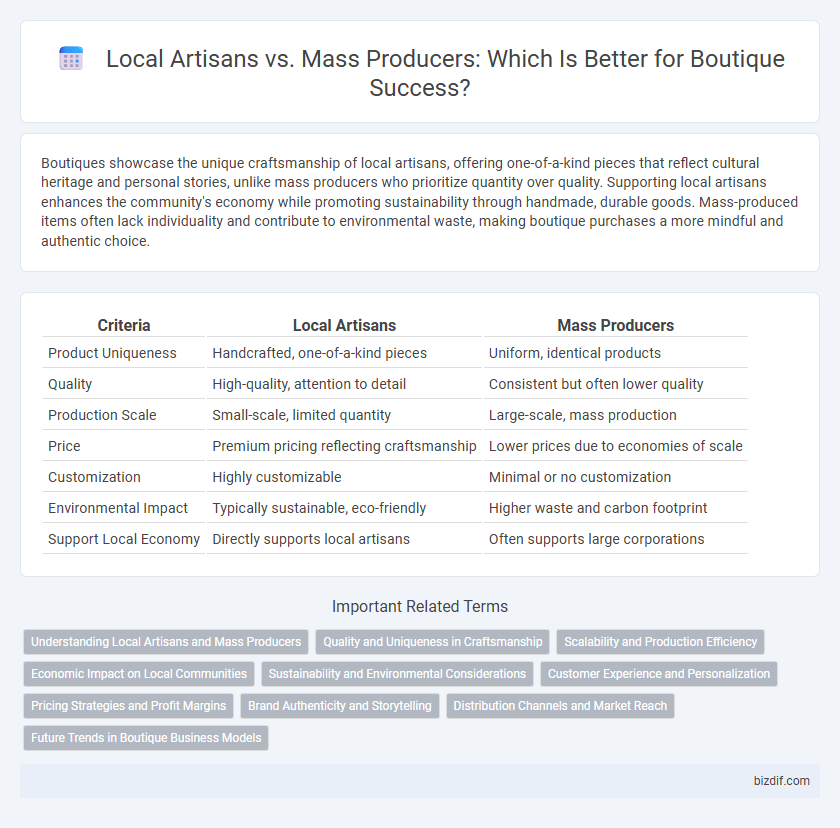Boutiques showcase the unique craftsmanship of local artisans, offering one-of-a-kind pieces that reflect cultural heritage and personal stories, unlike mass producers who prioritize quantity over quality. Supporting local artisans enhances the community's economy while promoting sustainability through handmade, durable goods. Mass-produced items often lack individuality and contribute to environmental waste, making boutique purchases a more mindful and authentic choice.
Table of Comparison
| Criteria | Local Artisans | Mass Producers |
|---|---|---|
| Product Uniqueness | Handcrafted, one-of-a-kind pieces | Uniform, identical products |
| Quality | High-quality, attention to detail | Consistent but often lower quality |
| Production Scale | Small-scale, limited quantity | Large-scale, mass production |
| Price | Premium pricing reflecting craftsmanship | Lower prices due to economies of scale |
| Customization | Highly customizable | Minimal or no customization |
| Environmental Impact | Typically sustainable, eco-friendly | Higher waste and carbon footprint |
| Support Local Economy | Directly supports local artisans | Often supports large corporations |
Understanding Local Artisans and Mass Producers
Local artisans create unique, handcrafted products emphasizing traditional techniques and cultural heritage, resulting in high-quality, exclusive items. Mass producers rely on automated processes and large-scale manufacturing, ensuring uniformity and affordability but often lacking individual craftsmanship. Understanding these differences helps consumers appreciate the value of supporting artisanal work while recognizing the efficiency of mass production.
Quality and Uniqueness in Craftsmanship
Local artisans prioritize quality and uniqueness in craftsmanship, creating intricate, hand-finished products that reflect cultural heritage and individual artistry. Boutique items crafted by these artisans often feature superior materials and meticulous attention to detail, distinguishing them from mass-produced goods. Mass producers focus on efficiency and uniformity, resulting in products with less character and lower durability compared to bespoke creations by skilled local craftsmen.
Scalability and Production Efficiency
Local artisans offer bespoke craftsmanship with limited scalability, emphasizing quality and uniqueness over volume. Mass producers achieve high production efficiency through automation and standardized processes, enabling rapid scalability and cost reduction. Boutiques leveraging local artisans prioritize exclusivity, while those adopting mass production balance exclusivity with wider market reach.
Economic Impact on Local Communities
Local artisans contribute significantly to the economic sustainability of their communities by creating unique, handcrafted products that foster niche markets and encourage local spending. In contrast, mass producers often siphon profits away from local economies, relying on large-scale operations and external supply chains that limit local job creation and economic diversity. Supporting local artisans enhances community resilience and preserves cultural heritage while helping to circulate money within the region, thereby strengthening the overall economic fabric.
Sustainability and Environmental Considerations
Local artisans prioritize sustainability by using eco-friendly materials and traditional, low-impact techniques that reduce waste and carbon footprints, contrasting sharply with mass producers who often rely on resource-intensive processes and synthetic materials. Boutique products crafted by artisans typically emphasize quality and durability, promoting longer product life cycles that lessen environmental degradation. Supporting local artisans also strengthens community economies and encourages responsible consumption, making boutique shopping an environmentally conscious choice.
Customer Experience and Personalization
Local artisans create unique, handcrafted products that offer customers personalized experiences tailored to their individual tastes and preferences. Boutiques featuring artisan-made goods often provide a deeper storytelling connection and higher quality compared to mass-produced items found in large retail chains. This emphasis on craftsmanship and personalization enhances customer satisfaction and loyalty by delivering exclusivity and authenticity.
Pricing Strategies and Profit Margins
Local artisans often adopt value-based pricing strategies that emphasize craftsmanship and uniqueness, allowing for higher profit margins despite smaller production volumes. In contrast, mass producers rely on economies of scale to offer lower prices but achieve thinner profit margins per unit due to high competition. Boutiques leveraging local artisans can justify premium pricing by highlighting exclusivity and quality, enhancing customer willingness to pay more.
Brand Authenticity and Storytelling
Local artisans infuse boutiques with unique brand authenticity through handcrafted items that tell rich, personal stories reflecting cultural heritage and craftsmanship. Unlike mass producers, their limited and carefully curated collections create a deeper emotional connection and differentiation in the marketplace. This storytelling enhances brand loyalty by offering consumers meaningful, one-of-a-kind products that resonate beyond mere functionality.
Distribution Channels and Market Reach
Local artisans often rely on direct-to-consumer distribution channels such as boutique stores, craft fairs, and online marketplaces that emphasize handcrafted uniqueness, resulting in a limited but highly targeted market reach. Mass producers utilize extensive retail networks, large-scale e-commerce platforms, and wholesale partnerships to achieve broad market penetration and high-volume sales. The contrast in distribution channels reflects divergent strategies in scalability and customer engagement within the boutique industry.
Future Trends in Boutique Business Models
Future trends in boutique business models emphasize collaboration with local artisans to create authentic, handcrafted products that cater to niche markets seeking exclusivity and sustainability. Mass producers face challenges adapting to consumer demands for personalized experiences and ethically sourced materials, which boutique businesses capitalize on through limited-edition collections and direct artisan partnerships. Integration of digital platforms for storytelling and e-commerce enhances the visibility of local craftsmanship, driving growth in boutique sectors focused on cultural heritage and eco-friendly production.
Local Artisans vs Mass Producers Infographic

 bizdif.com
bizdif.com